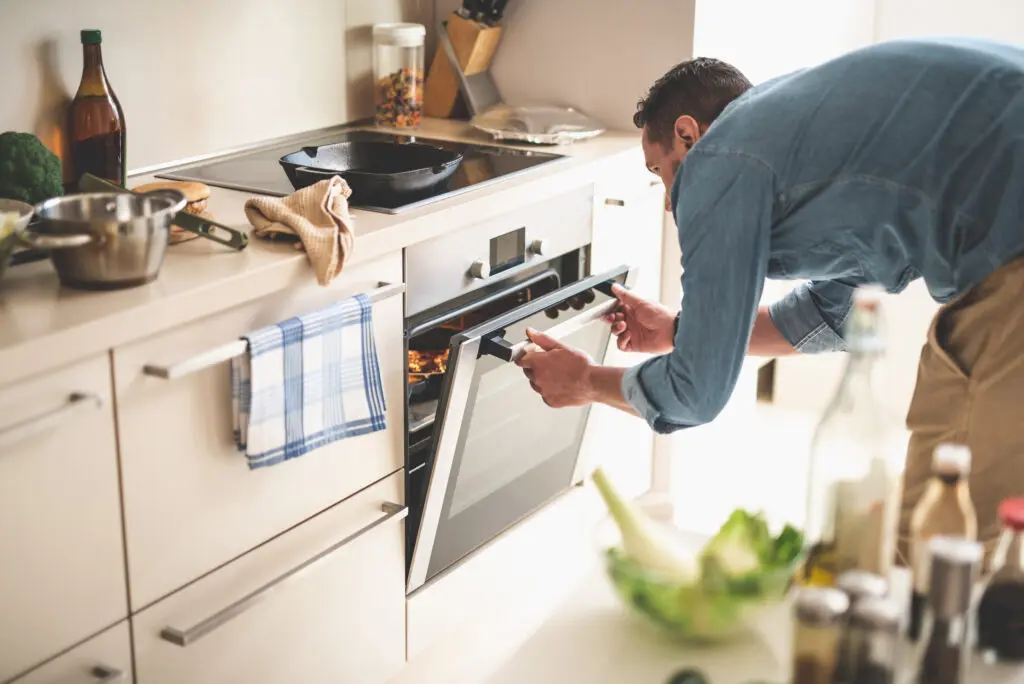Got dinner plans? A home-cooked meal can quickly go off track if your oven suddenly stops working. Whether you’re baking, roasting, or just heating leftovers, your oven is one of the most important appliances in your home. So, when it fails, it’s a big deal. With a little guidance on oven troubleshooting, you might be able to fix the issue on your own.
Whether it’s not heating at all or cooking unevenly, many common problems have simple explanations. In this guide, we’ll walk you through what to look for, what you can fix, and when it might be time to get professional help.
Table of Contents
Common Issues and How to Fix Them with Oven Troubleshooting
Your oven won’t heat correctly.
If your oven isn’t heating evenly or at all, the problem could be your temperature sensor. It may seem obvious, but if it doesn’t heat at the correct temperature, it could be costly or even dangerous. Food may undercook, or you could unwittingly start a fire.
An ohmmeter detects electric currents and can be used to test the temperature sensor to make sure that it is working properly. If the ohmmeter isn’t getting a good reading, then the sensor may need to be replaced.
If your temperature sensor is working, then the problem could be with the igniter or heating element. Before performing any repairs, be sure to unplug your oven.
A gas stove will have an igniter, which is located underneath the base plate inside the oven. An igniter can be removed and replaced using a screwdriver.
A heating element, also known as a baking coil, is found in electric ovens. It is found at the bottom of the oven and can also be easily removed and replaced using a screwdriver. Check your owner’s manual if you are making replacements to ensure that you are using the correct parts.
Once you have checked everything, you’ll want to recalibrate your oven:
-
-
- Preheat to 350°F.
- Place an oven thermometer inside and note the temperature after 20 minutes.
- Keep checking every 20 minutes for about 2 hours.
- Average the readings and adjust your oven’s dial accordingly.
-
Pro Tip: Can’t find your owner’s manual? Check the manufacturer’s website or try contacting them directly.
The interior oven light doesn’t turn on.
The light inside your oven is often similar to any other light bulb in your home. Luckily, that makes this an easy repair you can most likely handle on your own. Just remove the light bulb cover inside your oven. Usually, this requires turning it counterclockwise.
Remove the old bulb and replace it with an identical, new bulb. Be sure to check your owner’s manual if you are unsure of the light bulb type. You may also find this information printed on the bulb itself.
The oven door won’t shut.
An oven door that won’t shut is another common issue. Not only is this unsafe, but it also leads to heat leakage. Heat leakage means increased energy costs. Again, it’s best to unplug it and turn off the gas if you have a gas oven and range.
As part of your oven troubleshooting, check whether the door is properly aligned and inspect key components. The doors can usually be removed by pulling up on the door, but you may have to remove some screws depending on the model. Again, your owner’s manual is your best guide.
You should check your hinges and replace any that need replacing. Also, look for broken door springs. These can be replaced by removing the old ones with pliers and wrapping new springs around the bolts that hold them in place.
If your hinges and springs are in good working order, the door sensor may need to be replaced. Consult a professional if you suspect there’s an issue with the door sensor.
Burner Won’t Light on a Gas Stove
If your gas stove burner isn’t lighting up, it can be frustrating, especially when you’re in the middle of prepping a meal. You can light it with a match when the electric ignition isn’t working. But if that doesn’t do the trick either, it’s time for a little oven troubleshooting.
Let’s walk through what you can do before calling in a pro:
-
-
- Start by removing the burner grate, cap, and base. This gives you a clear view of what’s going on underneath and lets you inspect everything more closely.
- Look for food debris or grease buildup in the burner holes. Use a toothpick to gently clear them out, or compressed air to blow away any clogs that may be blocking the gas flow.
- Give everything a quick cleaning: the burner parts, the cap, and the grate. Sometimes, all it takes is a good cleaning to restore proper ignition.
- Check the wires connecting the igniter to the control module. If one looks loose or out of place, secure it gently. Loose wiring could be interrupting the ignition signal.
-
If none of these steps do the trick, there could be a bigger issue at play, like a faulty igniter or a problem with the gas line itself. Since that could be dangerous, it’s best to hit pause and call in a professional.
Electric Range Burner Won’t Heat Up
When one of your electric stove burners refuses to heat up, it can throw off your entire cooking routine. But before assuming the worst, try a few simple steps to get it working again. Many times, the issue is with the burner itself or a small component that’s easy to replace.
-
-
- First, unplug the non-working burner and swap it with another one that you know works from a different part of the stove.
- If the swapped-in burner works fine, it means your original burner is the problem. Time to replace it with a new one.
- If the replacement burner doesn’t heat either, take a close look at the socket. A burnt or loose socket could be blocking the connection.
- Still no heat? You may be dealing with a faulty infinite switch, the part that controls the burner’s heat. Consider replacing it if the other components check out.
-
This type of oven troubleshooting doesn’t require a ton of expertise, just a bit of patience and attention to detail!
The self-clean function doesn’t work.
Double-check your oven’s owner’s manual to ensure that you’ve started the self-cleaning procedure correctly. Each brand is slightly different, and timers and knobs need to be set in the right positions.
Note that bigger spills or messes may be too much for self-cleaning to handle. These will need to be cleaned manually to get your oven spick and span.
As always, if you’ve done everything properly but the self-cleaning cycle still isn’t working, it’s best to call a professional. The right home warranty plan can help to cover appliance repair costs and put you in touch with the right service person for the job.
Don’t have a home warranty? Consider protecting your investment today! Give us a call at 800-670-8931 to learn more and pick a plan tailored to your needs.
The oven control board isn’t working.
A reset should be the first step when you encounter a problem with your oven control board. The steps here are pretty simple:
-
-
- Unplug your oven from the wall outlet.
- Wait about one minute.
- Plug your oven back in.
-
This should clear the control board of any errors.
If resetting the control panel doesn’t work, you can try to access the control board. Again, make sure to unplug the oven first.
Next, use a screwdriver to loosen the screws holding the control panel in place. An ohmmeter will help you measure the electrical output of the panel to make sure that it is functioning properly.
If there is an issue, you may need to replace the control board. If you are uncomfortable with this kind of teardown and repair work, seek the help of a professional.
Can Regular Cleaning Prevent Oven Problems?
Definitely! Many oven issues stem from something as simple as a buildup of grime or food debris. That’s why regular maintenance is key. Whether you are scrubbing it down or using the self-clean feature, staying on top of the mess keeps your cooking range working like it should.
It’s a small step that helps avoid bigger problems, like uneven cooking or strange smells, before they start. A clean oven is a happy oven, and it’ll thank you with better performance.
Protect your oven with a home warranty.
With the proper care, most ovens will last 15 to 20 years. While there are many common oven problems you can solve on your own through oven troubleshooting. However, in certain complicated issues, you may require expert help. Of course, repair costs significantly more if you don’t have home warranty coverage.
For a typical repair, HomeAdvisor estimates that homeowners can expect to pay an average of $220.
While it depends on the type of repair, less involved fixes can fall as low as $100, while more elaborate issues on higher-end appliances can shoot upwards of $1,000. Labor costs and prices for replacement parts can also vary. Any way you cut it, that’s not nothing.
Save time and avoid expensive repair costs with a home warranty that can protect not only your oven but most of your home appliances and systems.
Get a quote today and find the right plan to defend your home and wallet against these unexpected costs and expenses.

